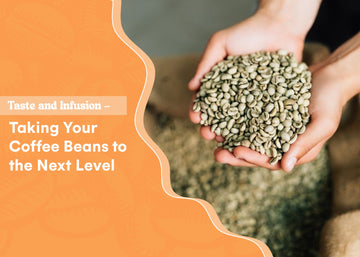Discover the Art of Infusing Coffee Beans for Flavor
It is an established fact that coffee is one of the most sought-after beverages in the world.
It has had, a rich historical & cultural significance which has spread out to all continents of the world. Originally, coffee was discovered in Ethiopia by a goat herder named Kaldi. He couldn’t help noticing that his goats would become very active, after eating the fruits of a particular tree. His curiosity aroused, he tried some & could feel a rush of adrenaline coursing through him.
After being successfully established in Ethiopia, it filtered down to the Arab region through traders, who passed through frequently. It got a tremendous response. By the 15th century, it was cultivated & traded by the Yemenis, which later spread out to Persia, Egypt, and Turkey. The importance of coffee, just cannot be ignored in the Arab world. Coffee was now called Qahwa in Arabic. The cafes that served them did so without milk or sugar. These cafes were hubs for meetings, music, chess, checkers & political discussions. Intellectual & poetic exchanges were encouraged & fostered.
As slowly but surely, continents were interlinked through trade, coffee filtered on down to Europe, where the initial response was hostile. However gradually, it found acceptance in cities like Venice, which had established links with the Arab world. By the 17th century, several coffeehouses had mushroomed all over Europe, specially in England, France, Austria, Germany.
From here on, coffee had migrated to the Americas, which was brought in, by the European colonizers. Soon, coffee plantations which flourished tremendously were set up in the Brazil, Central & South America. Today, today, we have countries like Columbia & Vietnam who are the biggest producers & exporters on the International market.
Coffee is generally cultivated & produced in equatorial territories. There are 2 kinds of coffee. Arabica & Robusta. Arabica is known for its smooth flavor & low caffeine levels whereas Robusta has a sharp, acidic taste with high levels of caffeine. At the end of the day, however, depends upon the origin of the beans, the process, and the roast level.
This actually brings out the different taste. From a sharp, acidic Ethiopian to a smooth & rich Brazilian taste.
Taste & Infusion
Taking coffee to the next level
- There were times when coffee was just a drink. Now it’s a lifestyle with many major companies, having jumped on this bandwagon. Now it is considered an experience, crossing all cultures & boundaries. In recent years, coffee has gone through a major evolution. What was casually seen as a simple cup is now, a beverage of art & sophistication, scaling it to newer heights. In other words, a signature of a certain lifestyle. This shift from a simple product has now deviated to a connoisseur’s choice. This has been largely due to the development of different natural flavors & innovative methods of infusion thus maximizing the flavors & taste of the beans.
- Now, with these flavors very much in demand, people are learning to differentiate flavors, profiles & origins. Various factors can determine taste:
- The variety of the beans, profile & processing for example – the taste of the Ethiopian beans differ from the Columbian and so on.
- Roasting is another key factor as we have 3 variables. Light, Medium, and Dark hence the taste differs accordingly.
- However, it’s not all about roasting or the beans. Infusion is a crucial factor as well. Modern methods of infusion along with innovative brewing have pushed the taste to revolutionary heights. Cold brew, Nitro coffee & Barrel aged coffee are some classic examples.
- When we talk infusion, we mean putting an ingredient in the water & observing the reaction of the water to the ground beans. There are different ways of brewing, all involving water control, temperature, pressure & flavor extraction.
- Cold Brew involves keeping the ground beans in cold water between 12-24 hrs. It results in a mild, smooth drink containing a lesser degree of acidity & bitterness, in comparison to a hot brewed coffee.
- Another popular method is Barrel Aging coffee. In this method, green coffee beans are stored in barrels, that hold whisky, rum, or wine. These beans, soak in the flavors from these barrels, creating a unique flavor of traces of these spirits minus the alcohol.
- More & more Baristas are experimenting & blending with different ingredients like cinnamon, and cardamom. These flavors are specifically popular in India & the Middle East.

Role of sustainability in coffee infusion –
With the growing awareness of the average consumer on his environmental & social responsibilities, he has become conscious about his cup.
Harvested coffee along with infusion & sustainability supports fair trade practices & environmental conservation along with coffee with a purer, nontoxic & enhanced taste.
Why are natural flavors added to green coffee?
- Green coffee is an organic category of unroasted coffee beans. They have an earthy flavor which is appreciated by a select few but not much by the larger part of the people, who find it unpalatable. This addition of natural flavors to green coffee can only make it a win-win situation.
- Green coffee beans, being unroasted have a distinct earthy flavor to it which is not normally appreciated by the average user. Adding natural flavors is a stroke of genius as it can only expand their market to unfathomable heights.
- The producers have added Vanilla, Caramel, Hazelnut, a few fruity flavors & much more. The keyword here is Natural. It has given the customers of this product line a thoroughly enjoyable experience. This has boosted their customer base as some categories of green coffee had a bitter or sour taste due to some compounds, making it unpalatable to many. With the addition of these natural flavors, it covered that taste.
- In a competitive market, the consumer is king. Therefore with an intent to increase their target audience, this was a master move by the producers. This helped the producers build a signature brand. This appealed to their customers as they were amenable to organic products but had to be palatable. An added benefit was that it catered to customer preferences.
- Natural flavors camouflage that earthy bitter taste, which has helped in increasing their market presence. A fact, which cannot be overlooked is the volume of health conscious customers is on the rise & are suspicious of any artificial preservatives. This has helped the producers in maintaining a clean, pure & caring image.
- The health-conscious segment is huge & growing. This blending of natural flavors with green coffee matches their campaign in making it more user-friendly to a larger audience.
- Everybody has their personal tastes. Some have a penchant for fruity and some, are spicy. This strategy of making the product more user-friendly can only build satisfaction, loyalty & trust for the customer which can only increase their target audience.

Conclusion
In conclusion, to enhance the flavor and infusion of your coffee experience, combine knowledge of the characteristics that set each bean apart with specific brewing methods. Pay attention to the flavor characteristics in the beans and adjust the coffee to suit your individual taste profile by selecting the origin and roasting degree. In addition to the inherent taste characteristics in the beans, infusions such as cold brew, pour-over, and French press provide varied flavor extraction dependent on the consumption.
This is the epitome of a creative and exploratory adventure. Try new things and don't be shy about sharing your findings with other coffee enthusiasts. With a little trial and inquiry, one may make a delightful and completely different cup of coffee. Your palate will soon be able to appreciate coffee's flavor in ways you never would have imagined, as taste serves as your guide.



